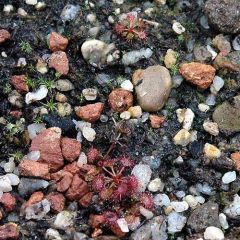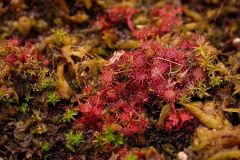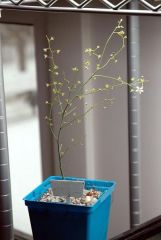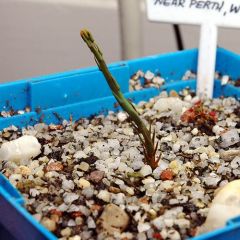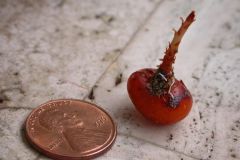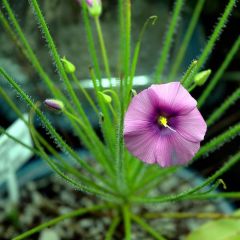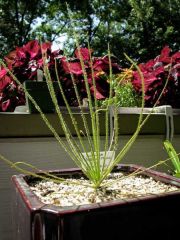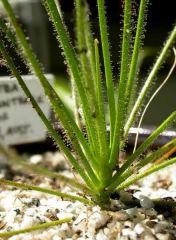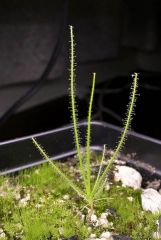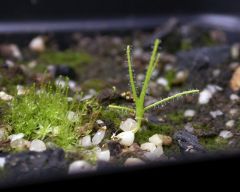
Tuberous D
Full Members-
Posts
24 -
Joined
-
Last visited
About Tuberous D
- Birthday 01/01/1912
Contact Methods
-
Website URL
http://
-
ICQ
0
Profile Information
-
Location
NE Ohio
-
Interests
Winter-growing drosera, Byblis, Drosophyllum, Temperate and alpine pings, Petiolaris - complex drosera, Eucalyptus
Recent Profile Visitors
2,624 profile views
Tuberous D's Achievements
5
Reputation
-
Here is something that you winter-growing droseraphiles may appreciate. A couple of weeks back I noticed signs of life stirring in several of my tuberous drosera pots. Most were from rosetted species just starting to break the surface with vegetative growth. One pot in particular caught my attention. It was my lone D. zonaria 'large form' that has been growing quite well for me going on three years. To my utter astonishment this pot was beginning to produce flowers! For a moment I thought I had mixed up the pot labels but quickly confirmed that this was, indeed, my zonaria. Up until now I had never had this species flower for me and had never even seen a picture of one flowering! From what I have read flowering for Drosera zonaria is a rare event. I located my macro lens and decided to document this event. Here are the results so far. Apparently the flowers are produced long before vegetative growth commences - September 29th October 5th October 14th More to come later in the season!
-
Here is something that you winter-growing droseraphiles may appreciate. A couple of weeks back I noticed signs of life stirring in several of my tuberous drosera pots. Most were from rosetted species just starting to break the surface with vegetative growth. One pot in particular caught my attention. It was my lone D. zonaria 'large form' that has been growing quite well for me going on three years. To my utter astonishment this pot was beginning to produce flowers! For a moment I thought I had mixed up the pot labels but quickly confirmed that this was, indeed, my zonaria. Up until now I had never had this species flower for me and had never even seen a picture of one flowering! From what I have read flowering for Drosera zonaria is a rare event. I located my macro lens and decided to document this event. Here are the results so far. Apparently the flowers are produced long before vegetative growth commences - September 29th October 5th October 14th More to come later in the season!
-
Here is an update on my growing adventures with D. neocaledonica - 2 1/2 years later! First off I would like to sincerely thank everyone who responded to my original post way back. Your advice gave me something solid to start off with. After experimenting with different growing areas including lowland, highland, and intermediate conditions I have found that this species grows very well for me in an intermediate room-temperature tank under lights. This is basically 15 - 25c. Humidity is not all that high, alternating between 40-70%. Lighting is provided by 4 40-watt standard shop light tubes, 2 cool white and 2 warm white. They are kept 15cm above the crown of the dews. I use a substrate of mostly New Zealand sphagnum mixed with some silica sand. In these conditions my original plant has grown to almost 4cm across and has flowered once, producing viable seed. Leaf cuttings have a medium strike rate and have produced additional plants. The most noticeable characteristic of D. neocaledonica is how slow it grows - about at the same rate of Cephalotus!
-
Everything that Siggi_Hartmeyer posted in his reply is very good advice and very true! I, too, have found that glanduligera does not like high temperatures and needs to be fed often in order to flourish. My method for germinating this species is identical to tuberous drosera. Sow in June and leave the pot in a place that will experience high outdoor temperatures all summer long. Let them bake! Protect your sown pot from rain that might wash away the seeds. This can be under an eave, piece of furniture, etc. Put the sown pot in a water tray in September. The soil should be constantly damp from this point onward. The seeds will start to germinate within a month after they have experience a prolonged period of cooler days and nights. A steep temperature drop at night (at least 15 degrees) will help them germinate. In general my glanduligeras grow from October/November until after flowering in April/May.
-
I would say that you have two options. The first is to take the tubers out of the pot and store them in a sealed ziplock snack bag with one or two strands of sphagnum that has just a hint of moisture in it. The other would be to take the pot that contains the tubers and soil and put the whole thing in a much larger sealable poly bag. In both cases you can store them indoors on a shelf in a closet or drawer. The tubers do not need any light so complete darkness is fine. They can stay in there until late summer/early fall. Then just put them back on your balcony and water as usual. Your plant might not have flowered if the tuber is still immature. I find that it takes a few years from seed for menziesii to flower.
-
Great habitat shots! Your photos of Byblis lamellata really show how this species gets blasted by the sun, not only from above but from below due to the white silica sand it grows in. How would you characterize the soil moisture conditions when you took the pictures? It looks really dry!
-
Fantastic macro shots! What lens did you use for these?
-
Thanks to everyone that responded to my original post. The pictures of well-grown plants are an inspiration! I have moved the pot to an area that is much more humid so we'll see if that does the trick with dew production. One thing that I wasn't aware of is the apparent ease of getting plantlets from leaf cuttings. I have taken several and will use the water float method under lights. Photos of the plant in habitat are a real eye opener. They grow in what appears to be massive amounts of laterite gravel and loam soil. I wonder to what extent this has, if any, on overall growth. In the past I grew several species of tuberous drosera whose habitats contain this substrate in a mix containing laterite. I found absolutely no difference in plant vigor or coloration.
-
Anyone out there grow this species? Two months back I had the good fortune of acquiring a single mature D. neocaledonica. I have it in a 5" pot with a peat/sphagnum/sand mix as substrate. The plant gets direct sun for about 5 hours a day, the rest of the time open shade. Watering is done via the tray system with the pot sitting in about an inch of water. Temperatures are typical summer conditions for the midwestern US: 80-90f day and 60-70f at night. The plant puts out new leaves on a regular basis - albeit very slowly. Now here's the thing. Very little dew is produced from the lamina even though other drosera species that grow in the same tray have no problem with this! Not much cultural information is out there largely due to the fact that this species is quite rare. The tips I could find are often conflicted. Some say it needs highland conditions while others report good results growing it in a lowland Petiolaris tank! Some say wet and others say just moist. If anyone has experience with this species please post your advice. Thanks!
-
Looking for information about how to keep and grow Petiolaris complex Drosera
Tuberous D replied to a topic in Drosera
Tom, Like Jim said - lots of heat,light, and humidity. Winter, Spring, Summer, and Fall. The native habitat for these species is always hot with most of the precipitation falling during the summer months. An enclosed tank under a bank of T-5's in a warm room would be ideal. The lights should be just a few inches above the plants. Mark -
Google : HTG Garden Supply Inc. I have purchased HO T5's from them several times. They are a very well run and reputable company and offer very good pricing and fast shipping. Last month I recieved a package containing two biax tubes. One arrived broken. I called and spoke to a representative who shipped out a replacement the next day. They offer all kinds of plant lighting and fixtures. Try them out!
-
-


